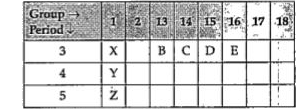Identify, the elements with the following property .
An element which is a soft and reactive metal.
To identify an element that is both a soft and reactive metal, we can follow these steps:
Step 1: Understand the Properties of Metals
Metals are generally known for their conductivity, malleability, ductility, and reactivity. Some metals are softer than others, and their reactivity can vary significantly.
Hint: Consider the general characteristics of metals and how they differ from non-metals.
Step 2: Focus on Soft Metals
Soft metals are typically those that can be easily cut with a knife. This property is often seen in the alkali metals, which are located in Group 1 of the periodic table.
Hint: Think about which group of metals is known for being soft and why.
Step 3: Identify Alkali Metals
Alkali metals, such as lithium, sodium, and potassium, are known for their softness and high reactivity. Among these, sodium and potassium are particularly noted for being very soft.
Hint: Recall the group of metals that are most reactive and soft.
Step 4: Select an Example
From the alkali metals, sodium (Na) and potassium (K) are prime examples of soft and reactive metals. Sodium is often highlighted due to its common occurrence and properties.
Hint: Choose one of the alkali metals to answer the question.
Final Answer
The element that is a soft and reactive metal is Sodium (Na). You can also mention Potassium (K) as another example.
Metals are generally known for their conductivity, malleability, ductility, and reactivity. Some metals are softer than others, and their reactivity can vary significantly.
Soft metals are typically those that can be easily cut with a knife. This property is often seen in the alkali metals, which are located in Group 1 of the periodic table.
Alkali metals, such as lithium, sodium, and potassium, are known for their softness and high reactivity. Among these, sodium and potassium are particularly noted for being very soft.
From the alkali metals, sodium (Na) and potassium (K) are prime examples of soft and reactive metals. Sodium is often highlighted due to its common occurrence and properties.
The element that is a soft and reactive metal is Sodium (Na). You can also mention Potassium (K) as another example.
Topper's Solved these Questions
- PERIODIC CLASSIFICATION OF ELEMENTS Book:OSWAL PUBLICATIONChapter:PERIODIC CLASSIFICATION OF ELEMENTS Exercise:NCERT EXEMPLAR (LONG ANSWER QUESTIONS)
Explore 36 Videos
- PERIODIC CLASSIFICATION OF ELEMENTS Book:OSWAL PUBLICATIONChapter:PERIODIC CLASSIFICATION OF ELEMENTS Exercise:BOARD CORNER (Short Answer Type Questions)
Explore 12 Videos
- PERIODIC CLASSIFICATION OF ELEMENTS Book:OSWAL PUBLICATIONChapter:PERIODIC CLASSIFICATION OF ELEMENTS Exercise:NCERT EXEMPLAR (MULTIPLE CHOICE QUESTIONS)
Explore 26 Videos
- OLYMPIAD 2019 - 20Book:OSWAL PUBLICATIONChapter:OLYMPIAD 2019 - 20Exercise:CHEMISTRY QUESTIONS (Is Matter Around us Pure)
Explore 1 Video
Similar Questions
Knowledge Check
Identify the soft metal among the following
AironBaluminiumCmagnesiumDpotassiumIdentify the soft metal among the following
AIronBAluminiumCMagnesiumDPotassiumWhich one of the following properties of an element is not variable ?
AValencyBEquivalent massCAtomic massDAll of three
Identify, the elements with the following property and arrange them in increasing order of their reactivity.
(a) An element which is a solt and reactive metal.
(b) The metal which is an important constituent of limestone
(c) The metal which exists in liquid state at room temperature.
View SolutionIdentify, the elements with the following property and arrange them in increasing order of their reactivity.
(a) An element which is a solt and reactive metal.
(b) The metal which is an important constituent of limestone
(c) The metal which exists in liquid state at room temperature.
View Solution
Identify the elements which have similar chemical properties as the element X.
View SolutionWhich of the following properties of an element is a whole number ?
View SolutionWhich one of the following properties of an element is not variable?
View Solution

